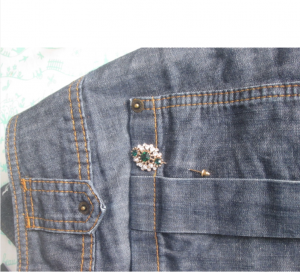 The performance of I live in it took place on March 17th as part of the International Women’s Day celebrations at Mulberry School for Girls. We had a good audience – about 60 people from the school and about 25 others. We had about 30 of these bejewelled hijab pins in the black curtains at the back of the stage. At the end of the piece each person touched four places on their body which reminded them of a story they had thought about or shared. We really thought about the quality of the touch, a slap, a gentle prod, a warm open hand…they were all there. We all had a partner, and at a certain point our partner went to collect a pin for us from the curtain, and when they arrived we pinned it onto one of the places. This is mine, pinned to a pocket just above the place where I have a tattoo. I got the tattoo in Ilfracombe, needing to mark something that had happened but that was quite invisible. I never told this story in the group, as many stories were not told verbally, but indicated through these varied touches. My 14 year old partner always wanted her jewel placed on her sleeve, indicating where she once broke her arm. She’d been resting on the floor in the gym after a boxing bout, and her dad dropped the weights he was lifting on her arm. She bore him no ill will. When we reflected back on the performance some audience members said that this was the point at which they felt most emotional, when our incredibly varied group of women were gently and respectfully giving each other a gift. And gift giving and receiving is very important in the world of understanding gratitude. I am searching my memory for the name of a tiny tribe whose whole identity depends on finding people willing to accept a gift from them. The gift giving begins a chain of connection which keep community alive. Any anthropologists out there who know- tell me!
The performance of I live in it took place on March 17th as part of the International Women’s Day celebrations at Mulberry School for Girls. We had a good audience – about 60 people from the school and about 25 others. We had about 30 of these bejewelled hijab pins in the black curtains at the back of the stage. At the end of the piece each person touched four places on their body which reminded them of a story they had thought about or shared. We really thought about the quality of the touch, a slap, a gentle prod, a warm open hand…they were all there. We all had a partner, and at a certain point our partner went to collect a pin for us from the curtain, and when they arrived we pinned it onto one of the places. This is mine, pinned to a pocket just above the place where I have a tattoo. I got the tattoo in Ilfracombe, needing to mark something that had happened but that was quite invisible. I never told this story in the group, as many stories were not told verbally, but indicated through these varied touches. My 14 year old partner always wanted her jewel placed on her sleeve, indicating where she once broke her arm. She’d been resting on the floor in the gym after a boxing bout, and her dad dropped the weights he was lifting on her arm. She bore him no ill will. When we reflected back on the performance some audience members said that this was the point at which they felt most emotional, when our incredibly varied group of women were gently and respectfully giving each other a gift. And gift giving and receiving is very important in the world of understanding gratitude. I am searching my memory for the name of a tiny tribe whose whole identity depends on finding people willing to accept a gift from them. The gift giving begins a chain of connection which keep community alive. Any anthropologists out there who know- tell me!
Blog
Parts and the Whole
On Saturday we had the whole group together for the first time in a long time. Through the day there was a perceptible shift from remembering units of the dance as separate chunks to beginning to dance through and feel the piece as one thing. This comes with repetition and remembering I guess, and what it feels like in the room is commitment. We are all letting go into the co-created piece of work. It’s interesting that , in parallel, something is
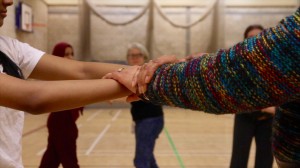
changing in the relationships. In a moment of reflection at the end, one of the participants, Roberta, observed that people had stopped only thinking about their own bits, but had started noticing each other and becoming more of a group.
I remember directing a touring show where two of the actors had a really difficult relationship. It made it quite a challenge for everyone to do this movement from the parts to the whole – other actors were tense when these two played a love scene, and the two of them had to do some hard work to make something work in the fiction that wasn’t working outside it. But they did manage, and it was possible to see the container that the performance makes, where it is possible, if you are all willing, put all your energies together.
‘I live in It: Different ways in
Last week I was working concurrently at Artsadmin with emerging artists from MA courses at Goldsmith’s ,and Jamie McCarthy, and with the community group, and Ellie Sikorski at Mulberry School for Girls, on the theme of thankfulness to the body. It was fascinating to transfer ways of working from one place to the other, and to get new ideas. With both groups we created the outline of a person on the floor, (nicknamed Mavis) on whom to put our stories. With the group at Artsadmin, we had a big pile of lovely found objects, and people placed their little piece of text with an object. Then I asked them to bring more objects to represent the stories that they did not want to voice. The
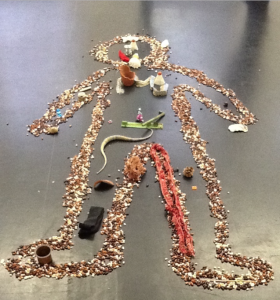
atmosphere changed and the figure filled up with potent images. The group created short solo movement pieces of all the stories, told and untold, and then thought about how much or little they wanted the audience to know what the stories were about. Should they point and say “Uterus” ?, said one of the women. This balance between the told and the untold stories is also present in the community group. At the moment all the stories they are telling concern the extremities – head, hands, feet, neck. One of the volunteers spoke about
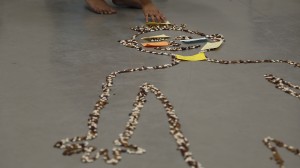
keeping her hands warm by sticking the under her thighs, and it suddenly felt as though the human territory had expanded. As facilitators I would guess we all feel more concern and feel more responsible within the community group – these are women from 14 to 80 odd who have only just met . They are not seasoned performers. We don’t want to push anybody to either tell or even visit what might be difficult moments that concern theri bodies. At the same time, I know that the moment at Artsadmin when ‘Mavis’ began to fill up with untold stories (that didn’t need to be voiced) , we deepened the process, and this is something we wanted in both groups.
‘I live in it’: Friendship with the body
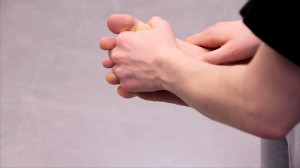
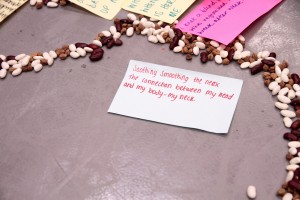
The workshops for ‘I live in it’ are slowly moving from games and explorations to building pieces of choreography. Ellie and I worked on a simple structure, where standing in a circle, each person turns to the one side to do a short sequence and then to the right, alternating between two partners. The little sequences came from work we had done thinking about parts of the body we felt ‘friendly’ with. Ellie and I had taken some time to sort out this question. If the question was about what parts of the body we ‘liked’ then straight away it became about judgements “people always say I have lovely hair” for example. We thought about this different way in because we hoped it would elicit different responses, and it did. We heard about loving to have your hair brushed, the help that hands have given, the joy of twining your hands with your toes in the bath…the reliance on hands for a fiddle player. These turned into simple gestures and duets, and Ellie chose from them to create the circle dance. One of the older woman, turned each time she had had her hair ‘brushed’ in the sequence, to say thank you to her partner. It is fascinating inhabiting other people’s gestures. It is a reminder that in movement work your are sometimes expressing what you feel inside, and sometimes you experience a feeling or a sensation because of the movement you take on.
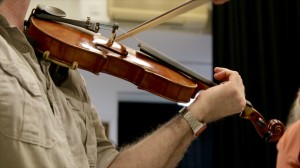
The Gratitude Enquiry
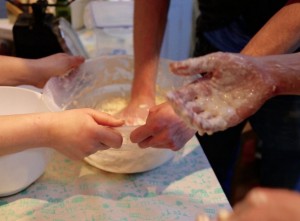 On December 15th 2015 my Arts Council England Research & Development grant arrived in my Bank Account, and the first reflection day of the project took place, in my kitchen. The whole year will include singing, making fans, dancing, recording sounds, filmmaking, photography and performance. Throughout the year the artists will meet up to reflect on the theme and the projects, and I decided to build these around the different modes of making.
On December 15th 2015 my Arts Council England Research & Development grant arrived in my Bank Account, and the first reflection day of the project took place, in my kitchen. The whole year will include singing, making fans, dancing, recording sounds, filmmaking, photography and performance. Throughout the year the artists will meet up to reflect on the theme and the projects, and I decided to build these around the different modes of making.
So, on December 15th, we gathered to make bread and talk about Gratitude. The we was Ellie (choreographer) Anna, (Sculptor), Jamie (musician) Chuck (Film–maker) and Mike (Baker). My dog and my son wandered in at various points.
I noticed that the first thing I had had to do was ask Mike to bring semolina flour, which I hadn’t been able to find, and to send out a general email asking people to bring big bowls, as I didn’t have enough. So the whole project began with this little mechanism of asking and receiving and saying thanks.
I will write more in another blog about what we thought about gratitude (just to say that empathy, guilt, judgment, humility, hierarchy, isolation, intimacy, abundance, deserving and reciprocity all got a mention)
What struck with me were all the moments of collaboration in the bread making. Anna held the bowl for Mike when he got very active, we helped each other scrape dough off our hands, we took turns to speak and to listen. We sat and had tea and chocolate biscuits while it rose. And at the end we dived into the bread, with big lumps of butter. We all took home loaves of ciabatta, except Chuck, who forgot hers, so she is owed one!
The Social Psychology research I’ve been reading tells me that gratitude makes you feel positive about the benefit you receive and the benefactor. So you know you are getting something but your appreciation extends to the giver. What I like in here is that you are focused on the gratification of your own need, but you are also ‘other oriented’. For me the research is to help me to see if this is what is going on between participants in participatory arts work, but of course it also needs to go on between the artists too, and between us and the participants, or why do we all need to be there?